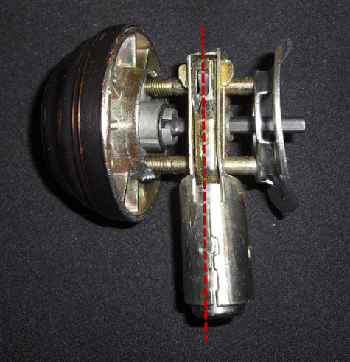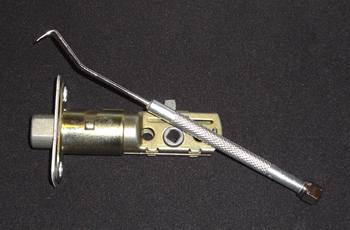Article and Photos by Samuel Hittle
There are numerous situations where through-the-lock forcible entry on a tubular deadbolt is warranted over conventional means. This approach may not be as fun or immediate as using the irons, but with practice it certainly isn’t slow. Gaining access this way for check welfare, smells and bells, and investigation of adjacent apartments or offices during a job demonstrates a higher degree of professionalism. It reduces unnecessary damage and will usually leave the occupant with the ability to resecure the point of entry quickly and affordably.
Over the years, the fire service has been taught to completely remove the face of tubular deadbolts and negotiate the crosshairs of the mechanism with our key tool. While this is effective, today we are seeing more and more doors come apart or gumming up the throw mechanism when applying the required force to perform the maneuver. This is largely in part because present day doors are being fabricated with less structural integrity (Media 1) while portions of the lock components are manufactured more substantially (Media 2). When such problems are encountered, we often find ourselves performing a modified through-the-lock or resort to gaining entry through conventional practices. When this happens, damage occurs, and we defeat our primary objective.

Media 1: This door is an example where the thin skin and particle board structural support come apart when trying to remove the face of the lock.

Media 2: This picture depicts the size of tension screws being used in today‘s locks and how easily the throw assembly can become bent, making it difficult to manipulate the throw. This is the lock we attempted to pull on the above door.
An alternative to completely removing the face of the lock and attacking the crosshairs is to go after the top of the throw mechanism. This is achieved by prying on the lock, or beating it down from the top just enough to see light through it. The majority of locks will have a rotating arm that can be manipulated with a 90-degree tool. A dental pick or an electrical probe will work well to move it (Media 3).

Media 3: Slightly bending the tool 7/8 inch back from the tip will help determine the depth of the tool in the door. This measurement is based on half the thickness of a commercial door. When used in a residential setting, remember these doors are only 1 3/8-inches thick as opposed to 1 ¾ inches, requiring the tool to be kept out slightly more.
Position the 90-degree tool between the housing and the rotating arm at a 45-degree angle toward the throw. Lift up on the arm while simultaneously moving the tool away from the strike plate to unlock the door. If the throw does not have a rotating arm, it will likely have a mechanism that slightly lifts up before sliding to the left or right. As with any through-the-lock procedure, jiggling the door a little will help loosen a tight lock. It is worth mentioning again that the application of too much force on the face of the lock can bend the housing of the throw, making it difficult to move.
To relock the door, reverse the process. In many cases, the lock can be returned to full service with a minor adjustment to the tension screws in the assembly
Media4: To unlock the door, place the point of the tool at a 45 deg angle toward the lock between the housing and the top of the arm
You can improve your chances of being successful using this method by visiting the local lock shop or hardware store and becoming familiar with different lock options. When you do, pay special attention to higher end Medeco, Mul-T-Lock, and all Schlage locks, which have built-in protection against this technique. Regardless, this is something that can be attempted once you have some give in the lock before executing a full removal. At the end of the day, we know forcible entry procedures are not one-size-fits-all. This is simply another option in the tool box that, with preplanning and practice, becomes a viable solution to entry on the majority of the tubular deadbolts we are confronted with on the street.
Download this article as a PDF HERE (394 KB).
Special thanks to Andrew Brassard
SAMUEL HITTLE is a fire lieutenant with Wichita (KS) Fire. He has an associate degree in fire science; is a Wichita HOT instructor; and is a contributing author to Fire Engineering and Urban Firefighter Magazine. At FDIC 2012, he is a HoT instructor for Truck Essentials and teaching a class on Window Work — Size Up and Tactics

